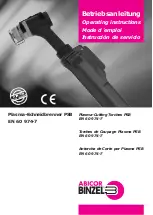
Page 9
For technical questions, please call 1-888-866-5797.
Item 96712
S
AFET
y
Op
ERA
TION
M
AINTENAN
c
E
S
ETU
p
General Operating Instructions
1. Make sure that the Trigger is in the
off-position, then plug in the tool.
NOTE:
Practice the welding procedure on
scrap material before the workpiece.
NOTE:
Rods or strips are not
necessary for tack welding.
2. Make sure the Nozzle is installed. Allow air
to run through the Nozzle to heat it up.
3. While waiting for the Nozzle to heat up,
position the workpiece to be welded.
4. Carefully apply the heated Nozzle to the
area or seams of plastic to be joined.
5. With small pieces, weld them just enough
to hold the pieces together. If the pieces
are large, you may need to weld along
the entire seam or connection point.
6. Avoid overheating tack points as doing so will
cause the plastic to warp, burn, or discolor.
Grind the tack points down to take off the edges.
7. When finished welding, set the Potentiometer to “0”.
Rest the Plastic Welder on its Cradle to keep the
hot Nozzle (1, 21, 22) from touching any surfaces.
8. Keep air flowing for five minutes after
disconnecting the electricity.
9. To prevent accidents, turn off the tool and
unplug it after use. Clean, then store the
tool indoors out of children’s reach.
Welding with Welding Rods
NOTE:
When welding with welding rods, use
the correct welding rod for the material being
welded. If welding vinyl, use a vinyl welding
rod. If welding PVC, use a PVC welding rod.
cAUTION!
Never place a welding rod
inside the Nozzle (1, 21, 22).
1. Material up to 1/2" thick can be welded.
As different types of plastic material
will melt at different temperatures, the
Potentiometer must be properly adjusted.
2. Hold the Welder with one hand. With the other
hand, hold the welding rod. Hold the welding rod
close to the Nozzle (about 1/4" to 3/8" away).
3. You are now ready to begin the welding operation.
4. When finished welding, set the Potentiometer to
“0”. Rest the Plastic Welder on its Cradle to keep
the hot Nozzle from touching any surfaces.
5. IMPORTANT! Keep the air flowing for several
minutes to allow the Welder to cool.
Then close the air supply.
Maintenance and Servicing
procedures not specifically explained in this manual must
be performed only by a qualified technician.
TO pREVENT SERIOUS INJURy FROM AccIDENTAL OpERATION:
Make sure that the Trigger is in the off-position and unplug the tool from its
electrical outlet before performing any procedure in this section.
TO pREVENT SERIOUS INJURy FROM TOOL FAILURE:
Do not use damaged equipment. If abnormal noise or vibration
occurs, have the problem corrected before further use.
cleaning, Maintenance, and Lubrication
1.
BEFORE EAcH USE,
inspect the general
condition of the tool. Check for:
• loose hardware,
• misalignment or binding of moving parts,
• damaged cord/electrical wiring,
• cracked or broken parts, and
• any other condition that may
affect its safe operation.
2.
cARBON BRUSH MAINTENANcE.
The carbon brushes may require maintenance when
the motor performance of the tool decreases or
stops working completely. To maintain the brushes:
a. Remove the Carbon Brush Cover on
each side of the motor housing.
b. Remove the carbon brushes from the
housing.
Keep track of which orientation
the old carbon brushes were in to prevent
needless wear if they will be reinstalled.
c. If either carbon brush is worn down by
more than 1/2, replace them both.






























